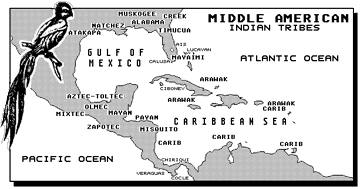
The long tailed Quetzal Bird is sacred to many native tribes in Middle America.

The long tailed Quetzal Bird is sacred to many native tribes in Middle America.
1/ Of the many native tribes in Middle America - the Mayans,
together with their ancestors - the Olmecs, were known to have
occupied the eastern shores of upper Central America some years
before the Carib and Arawak tribes sailed the islands of the
Caribbean Basin.
(Olmec artifacts of "jade jaguars" are believed to be
older than the Greco-Roman Era)
2/ Also inhabiting the western Caribbean coast are still the Payan tribe of the Bay Islands along northern Honduras and the Misquito tribe of eastern Honduras and Nicaragua.
3/ In the central and Pacific side of Middle America reigned
the Nahuatlan family of tribes - mostly the Zapotec, Mixtec and
later the Toltec/Aztec tribes.
(The Aztec tribe occupied much of the Mexican Gulf coast -
excluding the Yucatan peninsula)
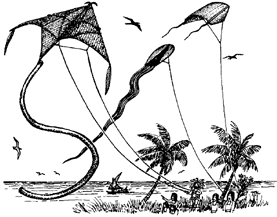
Quetzalcoatl flying his kites.
5/ He also introduced the nutritional value of maize and other beneficial plants of agriculture.
6/ As a medicine man, music man. and mathematician, Quetzalcoatl developed the art of writing and revealed the workings of a very unique and accurate astronomical calendar.
7/ However, his greatness as an admirable teacher of the arts and sciences overshadowed a jealous god who plotted to dishonor him.
8/ One day, while Quetzalcoatl was enticed to discover alcohol, he became drunk and was seduced into breaking the law with a young goddess.
9/ Rejected by the "ruling dynasty", he was shown no forgiveness and eventually ran away.
10/ He went eastward with a few friends toward the mountains, and after climbing, they finally descended to the eastern shore.
11/ There, as if to fulfill his destiny, he discarded his
remaning ornaments and sailed eastward into the sunrise on a raft
made of serpent skin - while promising those left behind that he
would return one day.
(The legendary story of Quetzalcoatl should not be confused with
a later fable regarding a similar shaman of Middle America named
Kukulcan - who brought about a violent and decadent period of
Mayan history; Furthermore, the ball-headed oriental monk by the
name of Kukulcan - and his "heart removing sacrificial
religion", violently overwhelmed Mayan theology into
replacing an earlier legendary shaman also found in Mayan history
named Itzamna)
[The Spanish Conquest of Middle America began when the natives
incorrectly assumed that Cortez was the returning "wind
god" from the east]
12/ So by linking the Middle American legend of Quetzalcoatl's
eastern departure from the Yucatan Peninsula with the Seminole
legend about the western arrival of a mound building tribe from
the Gulf Coast, and having this link reinforced by the discovery
of skeletal remains with Mayan features at the mounds near Ft.
Center and Fisheating Creek - perhaps there is reason to believe
that the first Mayaimi were Mayan seafarers from the Yucatan
Peninsula that followed Quetzalcoatl.
(It is important to realize that the original "kite-flying
shaman of Middle America" - known by the Nahuatlan name of
Quetzalcoatl, probably dates to the beginning of the Mayan
Culture, which began shortly after their ancestors, the Olmec,
disappeared from history)
13/ To even further this ancestral perspective of the first Mayaimi, something else was discovered at the mounds near Ft. Center and Fisheating Creek.
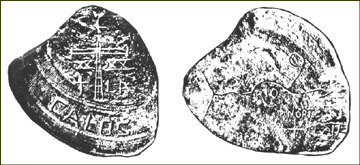
Ft. Center Shell letter information.
Courtesy of the book A CRACKER HISTORY OF OKEECHOBEE
by LAWRENCE E. WILL / Glades Historical Society.
15/ The apparent intent of the message on the large clam shell is to follow the map and find the Latin cross.
16/ In deciphering the map and other clues scratched into the
shell, one perspective could mean that the Latin cross can be
found inland near a river from the eastern shore of Lake
Okeechobee in the south Florida region once called Calos.
(The shape of the actual river on the shell map may have been
altered earlier this century because of new man-made canals which
changed the original water flow in the area)
17/ This conclusion places us again at the site of Big Mound City - with it's large mounds and long circular causeway.
18/ Now if the etching of the Latin cross is studied in detail it reveals something extra.
19/ First thought to represent some sort of Christian grave marker image, it becomes evident that the center part of the cross is made up of sections - and that these sections or "ribs" may represent the graphic impression of a re-enforced umiak (Eskimo canoe) made of wood and crocodile skin with two out-riggers to give the craft extra stability.
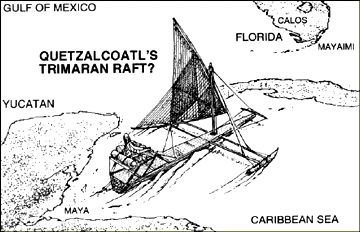
Did American natives ever use multihull rafts?
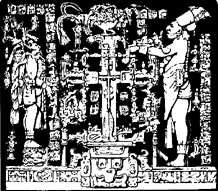
Mayan artwork showing two persons facing the "Altar of the Cross" wall at Palenque in the Yucatan.
22/ Could the cross-shaped umiak represent a kind of "sacred ark" to the Mayaimi at Big Mound City whereby the graphic layout of Quetzalcoatl's raft was preserved and worshiped over many generations?
23/ In continuing our investigation of Fontaneda's aquatic Indians. let us learn another short native legend which was documented in 1896 by a rare book entitled: THE SEMINOLES OF FLORIDA.
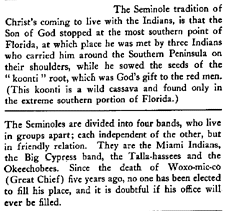
From the book: The SEMINOLES OF FLORIDA / Minnie Moore-Wilson (1896).
25/ Furthermore, the book advocates that at the turn of this
century, the Mayaimi tribe of southeast Florida was converted
into the present day Miccosukee community because of
"Christianizing efforts".
(Because the Seminole word "micco" translates into the
English phrase "great leader", and the Muskogee word
for December - or "fifth moon" is "sokee"
(month of the hawk), perhaps "micco-sokee" means
"the Saint of December" - thus the tribal association
with Christ and Christmas in December)
26/ Now let's move forward and explore some evidence of what became of the greater Miami tribe of Florida and North America.